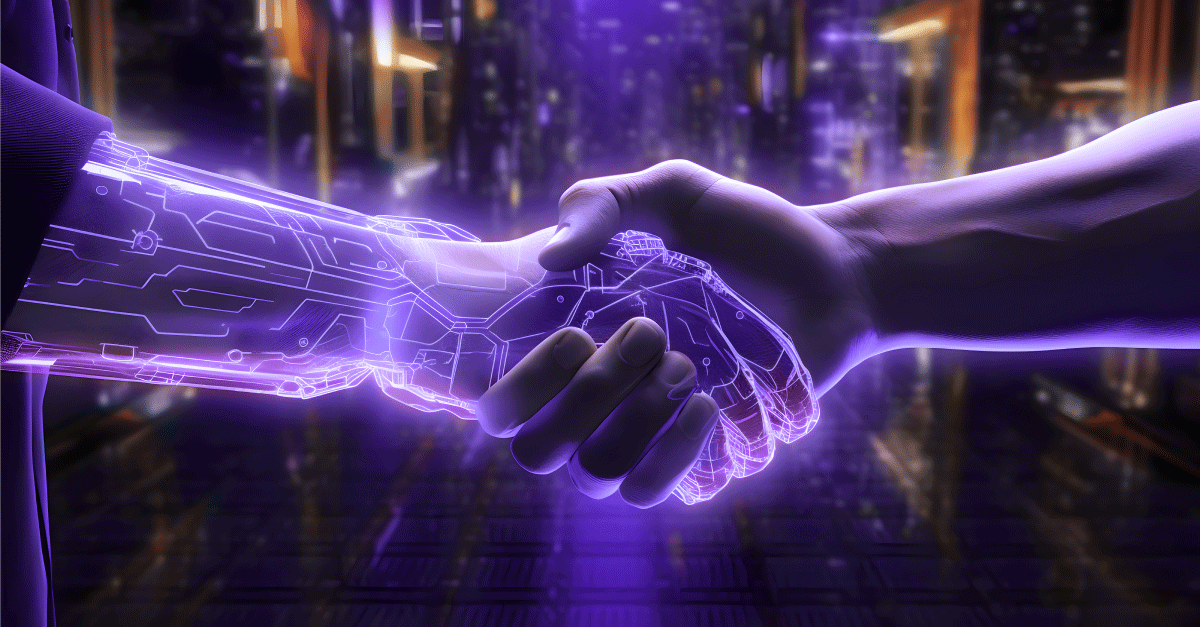What is the Digital Workforce? A Beginner’s Guide
September 27th 2023

In the ever-evolving landscape of business, there’s a buzzword that’s been making waves: the “digital workforce.” It’s not just a trend; it’s a seismic shift that’s transforming the way companies operate.
If you’re a business leader, you’ll want to pay close attention because understanding the digital workforce could be the key to unlocking unparalleled efficiency, innovation, and competitiveness.
In this blog post, we’ll give you an overview of the concept of the digital workforce, uncover why it’s a red-hot trend, and showcase real-world examples of its transformative power. Whether you’re a seasoned business leader or an aspiring entrepreneur, this is your chance to stay ahead of the curve and harness the full potential of the digital workforce.
Understanding the basics of the digital workforce
What is the Digital Workforce?
The digital workforce is a collective term that refers to a strategic integration of digital technologies, automation, and artificial intelligence (AI) into the traditional workforce. It’s not about replacing human workers; rather, it’s about augmenting their capabilities and automating routine, repetitive, and rule-based tasks. The digital workforce operates 24/7, is highly scalable, and excels at handling large volumes of data and tasks with precision.
At the heart of the digital workforce are digital workers, which can take various forms, including:
- Chatbots and Virtual Assistants
These are AI-powered software applications designed to interact with users, answer questions, provide information, and even perform simple tasks. They are commonly used in customer service, handling inquiries, and providing support.
- Robotic Process Automation (RPA) Bots
RPA bots are software robots that mimic human actions by automating repetitive tasks. They can navigate through computer interfaces, extract data, perform calculations, and enter information into various applications.
- Machine Learning Algorithms
These algorithms can be employed to make predictions, classify data, and extract insights from large datasets. In a digital workforce, they are often used for data analysis, pattern recognition, and decision-making.
- IoT Devices
Internet of Things (IoT) devices, such as sensors and actuators, are essential components of the digital workforce, enabling the automation of physical processes and the collection of real-time data.
- Cognitive AI
Cognitive AI systems are capable of understanding and processing natural language, enabling them to perform tasks like sentiment analysis, content creation, and more.
- Smart Analytics
Advanced analytics tools, including predictive analytics and data visualization, empower digital workers to provide valuable insights for informed decision-making.
- Autonomous Vehicles and Drones
In industries like logistics and agriculture, autonomous vehicles and drones serve as digital workers for tasks such as transportation, surveillance, and data collection.
- Virtual Employees
These are digital personas or avatars that can interact with customers or employees in virtual environments, providing assistance, training, or information.
The Role of Digital Workers
Digital workers are the heart and soul of the digital workforce. They tirelessly execute tasks with precision, consistency, and speed. They are not susceptible to human limitations, such as fatigue or errors due to repetitive tasks. Instead, they operate based on predefined algorithms and rules, adapting and learning from data to enhance their performance over time.
Digital workers excel in tasks that require high accuracy, repetitive actions, data processing, and real-time decision-making. They complement human workers by handling routine chores, allowing humans to focus on more creative, strategic, and complex aspects of their roles.
The integration of digital workers into the traditional workforce represents a paradigm shift, where humans and machines collaborate to achieve unparalleled levels of efficiency, productivity, and innovation.
The Digital Workforce: A paradigm shift in business
The concept of a digital workforce might sound like a futuristic notion, but it’s already reshaping industries across the globe. At its core, the digital workforce is about augmenting human capabilities with advanced technologies, such as artificial intelligence (AI), robotic process automation (RPA), and machine learning. This amalgamation creates a symbiotic relationship where humans and machines work together, enabling businesses to achieve unprecedented levels of efficiency, productivity, and innovation.
Why is the Digital Workforce trending?
The rise of the digital workforce can be attributed to several factors, each of which underscores its significance for businesses today:
- Enhanced Efficiency: The digital workforce operates around the clock, handling repetitive, time-consuming tasks with precision. This frees up human employees to focus on higher-value activities, leading to significant efficiency gains.
- Cost Savings: By automating routine tasks, businesses can reduce operational costs, minimize errors, and achieve more with fewer resources.
- Scalability: Digital workers can be easily scaled up or down to meet fluctuating demand, making it an ideal solution for businesses that experience seasonal variations.
- Data-Driven Insights: The digital workforce excels at data analysis, helping organizations make informed decisions based on real-time information.
- Competitive Edge: Adopting a digital workforce allows businesses to stay competitive in a rapidly evolving market where agility and innovation are paramount.
Real-world examples of the Digital Workforce
Let’s take a closer look at some real-world examples that illustrate how the digital workforce is transforming industries:
Healthcare
In the healthcare sector, the digital workforce is streamlining administrative processes, such as appointment scheduling, billing, and claims processing. This not only reduces administrative burdens on healthcare professionals but also ensures faster and more accurate patient care.
Finance
Financial institutions are using digital workers to perform fraud detection, risk assessment, and compliance checks. This not only ensures regulatory compliance but also mitigates financial risks.
Manufacturing
In manufacturing, the digital workforce is used for quality control, predictive maintenance, and supply chain optimization. This results in reduced downtime, improved product quality, and cost savings.
Customer Service
Digital workers are revolutionizing customer service by handling routine inquiries, processing returns, and providing personalized recommendations.
Retail
In the retail sector, digital workers are used for inventory management, demand forecasting, and even shelf stocking. This ensures that products are always available when customers need them.
What is the difference between digital workers and other digital labor solutions?
While digital workers are part of the broader ecosystem of digital labor solutions, they offer unique capabilities that set them apart. Unlike simple chatbots or basic automation tools, digital workers possess advanced skills, such as natural language processing and cognitive abilities. They can understand complex instructions, adapt to changing circumstances, and make decisions based on data analysis.
Another distinguishing feature of digital workers is their ability to collaborate seamlessly with human employees. They operate side-by-side, complementing each other’s strengths and bridging the gap between technology and human expertise. This collaborative approach ensures a holistic and efficient workflow, maximizing productivity and delivering superior results.
Wrapping Up
The digital workforce represents a transformative force in today’s business landscape. By harnessing the power of AI and automation, organizations can unlock new levels of productivity, efficiency, and innovation. As the digital workforce continues to evolve, businesses must embrace this technology to stay competitive and drive future growth. By leveraging digital workers, companies can empower their employees, enhance customer experiences, and pave the way for a future where humans and technology work hand in hand.
Don’t miss out on our weekly blog posts and LinkedIn updates about the fascinating advancements that will propel your business.
Ready to see what we can do for you?
In the right hands, artificial intelligence can take human performance to a hitherto unimaginable level. Are you ready for evolution?




